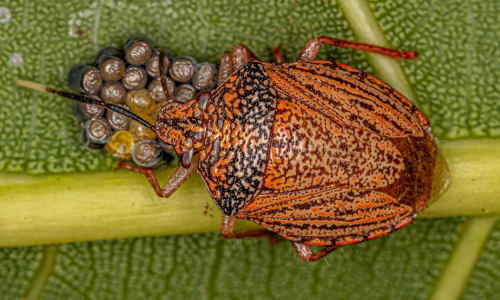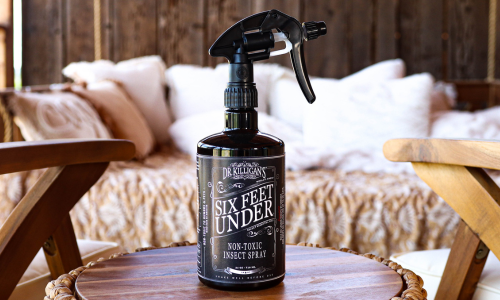Imagine your tranquil Texas evening suddenly invaded by a tiny, shield-shaped intruder barely larger than a fingernail: the brown marmorated stink bug. This paper-thin flyer, originally from Asia, now poses a significant challenge to homeowners and farmers across the Lone Star State. But what makes Texas so inviting to these pests, and how can we safeguard our homes and gardens from their intrusion?
Join us as we delve into the secrets of managing these resilient invaders and uncover effective strategies to maintain our living spaces serene and stink bug-free.
Meet the Texas invader: The brown marmorated stink bug
Originally from Asia, the brown marmorated stink bug hitched a ride as a stowaway pest on an oceangoing vessel in the mid-1990’s, making its first unwanted appearance in Pennsylvania. From there, it has expanded its territory into Texas, adapting seamlessly to the diverse climates of the Lone Star State. (This adaptation has turned them into significant pests).
These insects, belonging to the Pentatomidae family, are deceptively quaint with their shield-shaped bodies and lengthy antennae. However, their defining characteristic—a potent odor reminiscent of coriander released when threatened—marks them as unwelcome visitors.
Their flight, though not their strongest attribute, is enough to carry them into our living spaces. Stink bugs exhibit a slow and cumbersome flight pattern, usually staying close to the ground, and can be easily swayed off course by the wind.
Unpacking the stink bug attraction: Insights into their Texas invasion
Before exploring the profound impact stink bugs have on Texas's agriculture, let's understand what draws these pests into our homes and fields:

- The allure of bright lights
- The quest for warmth
- Texas’s rich agricultural lands, (which offer a rich feeding ground)
- Moisture and shelter
- Pheromonal invitations
With these factors in mind, the stage is set to delve deeper into why Texas —in particular— faces such a pronounced challenge with stink bugs.
Fact: Besides their notable stench, stink bugs release a special pheromone to signal a safe winter haven to others. Imperceptible to humans, this scent draws more stink bugs, heightening infestation risks in homes.
Why stink bugs thrive in Texas: A closer look at the agricultural connection
Texas is particularly vulnerable to the encroachments of stink bugs. Here's why these pests find the Lone Star State an ideal habitat:
- Diverse agriculture: Texas's agricultural diversity, especially its significant cotton fields, provides a veritable feast for stink bugs. Given that Texas accounts for approximately half of the U.S. cotton acres and about 40% of total production, it's a major battleground in the fight against these pests.
- Species variety and mobility: Texas is home to a variety of stink bug species.
- In South and East Texas: The southern green stink bug, green stink bug and brown stink bug are particularly notorious for their attacks on cotton fields. These pests are strong flyers.
- In West Texas and the Winter Garden region of South Texas: The conchuela stink bug takes precedence, attaching sorghum and corn, (which are two of the top seven crops in Texas).
- Climate: The climate of Texas, with its warm temperatures and mild winters, provides an accommodating environment for stink bugs to overwinter and proliferate.
This confluence of factors—rich agricultural resources, a variety of stink bug species with strong flying capabilities, and a conducive climate—makes Texas a prime hotspot for stink bug activity. The economic impact on the state's cotton production underscores the need for effective management strategies to protect Texas's crucial agricultural outputs from these voracious pests.
Fact: As cold weather arrives, stink bugs enter diapause, a hibernation-like state where they neither feed nor reproduce, waiting for spring's warmth to become active and reproduce again.
A feast for pests: The stink bug diet
Outdoors: Stink bugs are notorious for their indiscriminate feasting on a variety of crops. Using their piercing, straw-like mouthparts, they puncture the skin of plants to suck out the sweet, life-sustaining juices. This not only depletes the moisture from the plants but also leaves behind a trail of destruction, characterized by unsightly blemishes and significantly reduced yield and quality of fruits and vegetables.

Indoors: While they may occasionally take a nibble on houseplants or partake in any fruits or vegetables left unattended on the counter, such incidents are rare.
Predominantly, their dietary preferences are geared towards outdoor crops and plants, meaning they're more likely to succumb to starvation or dehydration inside your home than find a satisfying meal.
Fact: The bolls of cotton plants, which open at harvest, are especially at risk, with stink bugs capable of destroying entire bolls or pods through their feeding.
Do stink bugs bite?
While stink bugs possess piercing-sucking mouthparts, these are primarily adapted for feeding on plants, not for biting humans or animals. Nevertheless, should a stink bug feel threatened or be mishandled, it might defensively use its mouthparts. Such a defense mechanism could result in a pinch or a minor prick, causing slight discomfort but generally no serious harm.
Is it okay to kill stink bugs?
Deciding whether or not to kill stink bugs is a personal choice. Here's some guidance: if you opt for their removal, consider doing so without causing harm inside your home. Crushing these critters indoors can unleash their notorious odor, making physical extermination less desirable.
To prevent them from entering, it's wise to maintain a tidy perimeter around your home, trim back vegetation and ensure that entry points are sealed.
A Texas-sized solution to stink bugs
In dealing with stink bugs in your home, Texans have a variety of strategies at their disposal, each designed to mitigate the pest's presence without triggering their unpleasant defense mechanism.
- Catch and release: Gently capture the stink bug and release it back into the wild. There's no need for harm, as they pose no direct threat to humans.
- Vacuum removal: For those wary of direct contact, using a vacuum cleaner offers a convenient way to capture and dispose of stink bugs. It's an effective strategy to avoid disturbing the pests and risking their odor release.
- Make a DIY garlic spray: Creating a repellent from garlic and water can deter stink bugs. Follow these steps:
- Crush several garlic cloves and mix them with water.
- Allow the mixture to sit for a day or two, allowing the garlic to infuse the water.
- Strain the mixture to remove any solids, and pour it into a spray bottle.
- Spray the mixture directly on the stink bugs and around the areas where they are commonly found, such as window sills and door frames.
- Repeat the process every few days until the stink bug infestation has been eliminated.
- Use Dr. Killigan's Six Feet Under Plant-Powered Insect Spray: Opt for this non-toxic, environmentally-friendly powerful formula, crafted with clove and cinnamon oils, for an immediate solution to stink bug invasions. It kills stink bugs on contact and also boasts a 30-day residual effect, ensuring your home remains protected and pest-free for an extended period.

By embracing these tactics, you can effectively manage stink bug populations around your Texas home, ensuring both your living spaces and gardens remain free from these pesky invaders.
Conclusion
As we navigate the challenges posed by the stink bug in Texas, it's clear that safeguarding our homes from these persistent invaders is paramount. With the insights gained on what attracts these pests and effective strategies for managing them, Texans are well-equipped to protect their living spaces. Whether it's utilizing the simple catch-and-release method, sealing up potential entry points, or deploying Dr. Killigan's Six Feet Under, each measure plays a crucial role in maintaining stink bug-free homes.
Emphasizing proactive prevention and informed action, we can ensure our households remain sanctuaries, undisturbed by the presence of these unwelcome guests. By focusing our efforts within our homes and immediate surroundings, we contribute to a broader initiative of pest management that upholds the well-being of our communities and the natural environment of the Lone Star State.









